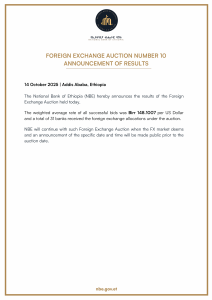29 September 2025 | Addis Ababa, Ethiopia
The National Bank of Ethiopia’s Monetary Policy Committee (MPC) held its fourth meeting on September 25, 2025. In line with its roles and responsibilities under the NBE Establishment Proclamation No. 1359/2025, Article 23, the MPC proposes monetary policies for endorsement by the NBE Board. These policies are designed to align with the central bank’s primary objective of maintaining price stability while fostering sustainable and inclusive growth. As part of this process, the MPC reviews Ethiopia’s recent real sector performance, inflation trends, and developments in the monetary, financial, fiscal, and external sectors, as well as global conditions that significantly affect the Ethiopian economy. Based on its in-depth assessment of these developments and the near-term outlook, the Committee recommends an appropriate monetary policy stance for the period ahead.
The Committee reviewed major developments in the following areas:
- Inflation: The Committee noted that the August 2025 inflation rate, at 13.6 percent, reflects a continued downward trend. The ongoing moderation in inflation over recent months was attributed to the tight monetary policy stance, improved agricultural production, and the gradual adjustment of key administered prices. Looking at the specific components, the MPC observed that food inflation declined to 12.7 percent, a considerable slowdown from 18.8 percent recorded a year earlier. In contrast, non-food inflation stood at 15.1 percent, showing a slight increase compared to the same period last year, partly due to exchange rate pass-through effects. Meanwhile, the month-on-month inflation rate for August 2025 fell to 1.1 percent, indicating a moderate easing of new price pressures in the economy.
- Growth and Economic Activity: The Committee noted that economic activity indicators continue to show strong growth momentum, as captured by NBE’s latest Composite Index of Economic Activity (CIEA), which tracks high-frequency data in various segments of the economy. Accordingly, multiple supply-side initiatives in agriculture, robust growth in key parts of the industrial sector (aided in part by the easing of FX constraints), exports of goods (particularly coffee and gold), and services such as air transport and tourism have experienced noticeable growth over the period. However, declines were observed in some areas, such as imports of semi-finished goods and consumer goods, compared to the previous fiscal year.
- Monetary developments: Monetary aggregates have been expanding at a faster pace, reflecting the moderate easing of credit policies as well as fiscal and external developments. Year-on-year growth in broad money and base money stood at 23.1 percent and 70.7 percent, respectively, as of end-August 2025, while growth in domestic credit was 14.0 percent. By the end of August 2025, the outstanding loans of the banking system had expanded by 5.4 percent compared to the June 2025 balance. The accelerated growth of reserve money reflects NBE’s gold-related foreign exchange accumulation and the corresponding injection of local currency liquidity into the banking system. Although reserve money growth appeared expansionary, the credit cap policy constrained the money multiplier and limiting the expansion of broad money.
- Interest rate developments: The Committee noted that short-term market interest rates have been on a declining trend, while remaining close to the policy rate and positive in real terms, which is an encouraging sign for money market development. In the Treasury Bills (T-bills) market, the weighted average yield on 91-day T-bills stood at 15.0 percent in August 2025, down from 17.6 percent in June 2025, reflecting improved liquidity conditions. In the local currency interbank money market, the weighted average rate was 13.7 percent in August 2025, also indicating improvement in liquidity, and remained within NBE’s interest rate corridor of 15 percent, plus or minus three percentage points. Cumulative transaction volumes in the local currency interbank money market continued to expand steadily, reaching Birr 945.1 billion as of October 2024.
- Banking and Financial Sector: The banking sector remained safe and sound, characterized by low non-performing loans (NPLs) and adequate capital levels. However, certain segments of the sector continue to face liquidity pressures due to high loan-to-deposit ratios. The establishment of an interbank money market and the introduction of a Standing Lending Facility by NBE have helped ease these short-term liquidity challenges.
- Fiscal position: Fiscal policy during the review period appeared prudent, disciplined, and aligned with NBE’s tight monetary policy stance. In the first two months of FY 2025/26, similar to the pattern observed in the previous fiscal year, the government refrained from borrowing from NBE, a development that has strongly supported the Bank’s tight monetary policy stance.
- External sector: The Committee acknowledged that, following the comprehensive reform of July 2024, the external sector has continued to perform impressively. This is reflected in the strong growth trajectory of goods exports, particularly gold and coffee, alongside significant growth in remittances and moderate gains in net services trade. These developments have helped sustain current account surplus, while the overall balance of payments has remained in surplus, continuing the robust performance observed last year.
- Global environment: According to the IMF’s July 2025 projection, global economic growth is expected to be slightly higher than the previous forecast. Global GDP growth is projected at 3.0 percent in 2025 and 3.1 percent in 2026. The forecast for 2025 is 0.2 percentage points higher than the April 2025 outlook, while the 2026 projection is 0.1 percentage points higher. This upward revision reflects stronger-than-expected front-loading in anticipation of higher tariffs, lower average effective U.S. tariff rates than those announced in April, improved financial conditions, partly due to a weaker U.S. dollar; and fiscal expansion in several major economies. Global inflation is projected to continue declining, with headline inflation falling to 4.2 percent in 2025 and 3.6 percent in 2026—virtually unchanged from the IMF’s April 2025 forecast. This reflects ongoing trends of cooling demand and falling energy prices. However, tariffs, acting as a supply shock, are expected to gradually feed into U.S. consumer prices, with the main impact on inflation likely in the second half of 2025.
MPC Assessment and Decision
While the ongoing progress in reducing inflation is encouraging, the Committee noted that the rate remains above the medium-term target of achieving single-digit inflation. Accordingly, the Committee agreed that a disinflationary monetary policy stance remains appropriate and should be maintained until further progress is achieved. The Committee also emphasized that lifting the credit ceiling represents an important step toward shifting from direct to indirect monetary policy instruments. However, it stressed that careful calibration of the credit ceiling is required to ensure that the resulting credit expansion does not inadvertently loosen the monetary policy stance or create risks to financial stability. In light of these considerations, the Committee judged that the current prudent monetary policy stance should be maintained.
Consistent with this view, the MPC recommended and the NBE Board approved the following monetary policy actions:
- First, the Committee decided to maintain the National Bank Rate at 15 percent while also keeping unchanged existing rates applicable for NBE’s Standing Deposit Facility, Standing Lending Facility, and reserve requirements on bank deposits.
- Second, the Committee agreed that lifting the credit growth ceiling is an important step in advancing the new monetary policy framework, with the policy rate serving as the key signal of NBE’s stance. However, to safeguard financial stability and preserve recent progress in reducing inflation, the Committee concluded that fully removing the ceiling at this stage would be imprudent, given NBE’s firm commitment to a tight monetary policy. While the removal of the ceiling had been anticipated for September 2025, contingent on sustained disinflation, the Committee recommended retaining a credit growth target for now, with a moderate upward adjustment. Accordingly, the Committee has decided to raise the credit growth target from 18 percent to 24 percent for FY 2025/26. The Committee will revisit this matter in its upcoming meetings.
- Third, the Committee noted that NBE will make use of the full range of market-based monetary policy tools at its disposal. These include the central bank’s policy rate, open market operations, foreign exchange interventions, and adjustments to reserve requirements, among others. The tools may be applied individually or in combination, as needed, depending on prevailing inflationary and monetary conditions.
In closing, the Committee decided that its next meeting shall take place in December 2025
Monetary Policy Committee
National Bank of Ethiopia
September 29, 2025


